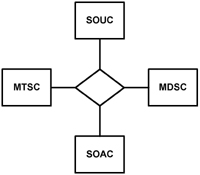The Embedded Intelligence (EI)
Pattern describes a repeating reference model of the nature of all systems that contain embedded intelligence:
- Assisting in predicting and understanding the underlying challenges and answers of specifying requirements and designs, planning, analyzing, and supporting intelligent systems;
- Enabling understanding of the roles of humans as intelligent agents within larger systems;
- Improving ability to plan and manage hybrid combinations of different controls technology generation, human versus automated roles, and migration across generations of control platforms and releases;
- Providing an improved framework for planning and managing technologies such as sensors, actuators, data communication networks, and interfaces including human-machine, machine-machine, and human-human;
- Enabling a clearer understanding of the connection of internal systems and external industry, market, or technical standards concerned with controls, instrumentation, manufacturing, aerospace, telecommunication, or other domains (e.g., ISA).
- Improving understanding of the underlying nature of all control system applications, through the System Management Functional Areas of Fault Management, Performance Management, Configuration Management, Security Management, and Accounting Management.
- Improving understanding of control hierarchies and span of control in management.


